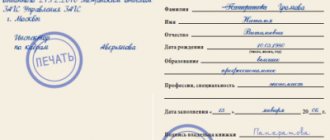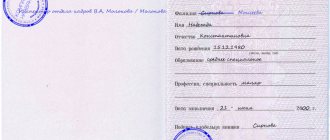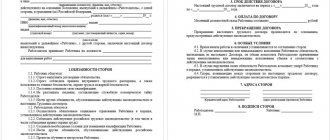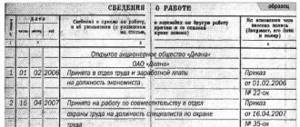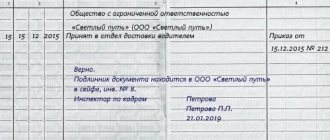Home / Labor Law / Personnel Management / Personnel Records
Back
Published: 08/07/2016
Reading time: 8 min
0
873
Filling out a work book with errors is a fairly rare phenomenon, but it still occurs in practice. After all, even professionals in their field, and even more so newcomers who have recently started working in the personnel department, are not immune from mistakes.
The reasons for incorrectly entering information can be very different. For example, due to inattention, the personnel officer missed something. Or the work book was received by the personnel department and already contained errors. In small companies, filling out such documents is often done by a secretary or other specialist who does not have the relevant experience.
Even one word entered incorrectly or a miscalculation with the numbering of the next entry will be considered an error. Every working citizen must carefully monitor what information has been entered into his work book. For example, the calculation of pension payments depends on the correctness of filling out. Therefore, if an error is detected, you must contact your immediate supervisor or a member of the HR department.
- What does the law say?
- Is it possible to fix it?
- Correction procedure
- What bugs are being fixed? Invalid entry
- Invalid date
- Error in details
- Incorrect award details
- Cover page errors
- Incorrect education record
Regulatory documents and acts
- Labor Code of the Russian Federation. This is the most important document that you need to rely on when working with labor documents. Particular attention should be paid to the wording and correct indication of articles of the Labor Code of the Russian Federation.
- Rules for maintaining and storing work books dated April 16, 2003
- Instructions for filling out work books dated 10.10.2003.
Read more about filling out the title page here.
Correction of education data
New data on education, profession, specialty are entered as an addition to the existing data (clause 2.4. Instructions). Additions and corrections are made in the appropriate lines of the form, and an entry is made on the inside cover with a link to the supporting document (for example, a diploma).
If the first page does not contain information about the employee’s education, profession or specialty, the information is entered in the blank lines. If they have already been introduced before, then additions are made. Previously specified information about education is not crossed out. If an error in the education section is discovered later than the initial completion, then corrections are made to the title page in the manner prescribed by clause 2.3 of the Instructions.
Here is an example of how to correct an error in a work book if educational information is incorrectly indicated:
Who has the right to correct?
An entry in the work book about a change of surname or an entry about the category in the work book can correct a rather limited circle of people. This cannot be done without special powers and without a reason. If errors are found in the Labor Code, they are corrected at the previous or current job and in court.
Not a single regulatory document provides a list of positions for which the exclusive right to make, certify and correct entries in the Labor Code is provided. The Rules only clarify that those responsible for such work in the organization are appointed by a special order.
If the organization is small and does not have a separate personnel service, either the employer himself or any specialist appointed by his order can maintain and correct work books: an accountant, secretary, administrator, office manager, etc.
If work is provided by an individual, the law does not allow him to maintain and correct work books.
What to do if the personnel officer forgot to provide the required information?
At any time, after discovering an oversight made by an authorized person, you can submit a request to correct the error. If there is a lack of information in the second column, it is under no circumstances permissible to enter it in your own hand.
In this case, you need to return to your previous place of work to the HR department, or to another person responsible for the movement of work books.
Point out the error and, if necessary, write a statement to the head of the organization about the absence of the required information. Missing information must be filled in by an authorized person.
If an employee finds an error, what should he do?
Typical errors in work books are found by their owners or employees empowered to maintain labor documentation during dismissal, acceptance and revision of personnel documents. One of the most common mistakes: the date in the work book is indicated incorrectly.
If the owner of a trading company finds an error on the employee information page, then he needs to:
- Collect documents with correct information (diploma, passport, marriage or divorce certificate, etc.);
- Submit an application to the manager with a request to correct the erroneous entry;
- If the case concerns the first name, patronymic and last name incorrectly recorded by the previous employer, go to court to prove ownership of the Labor Code and correct the entry.
If the owner of a trading company has discovered an error in the “Work Information” and “Award Information” blocks, then he needs to:
- Submit an application to the head of the organization where the mistake was made with a request to correct the incorrect entry in the Labor Code;
- If the employee has already registered for a new job, then they will not give him a work book for corrections, so you need to submit an application to the head of the organization where the mistake was made, asking for documents (copies of orders, employment contracts, certificates, extracts, etc. ), on the basis of which the new employer can correct the detected errors;
- If the previous organization no longer exists, the documents necessary for correction can be requested from the archives of the city where it was registered.
Do spelling errors need to be corrected?
Spelling errors are usually caused by inattention. If a letter is missing or mixed up in the termination information, no one will probably notice. But when a spelling error occurs in a specialty, a company name, or an appointment record, it can be costly for the employee. If, when assigning a pension, Pension Fund employees find fault with a “typo,” the employee will have to prove the right to state pension provision and length of service in court.
General rules for correcting errors
For incorrect data in information about work and awards, strikethroughs, erasures, amendments, etc. are not applicable. You can only write down that the data entered under a particular number is invalid, and then add the correct information.
When correcting errors on the first page, it is allowed to carefully cross out the incorrect data and add the correct data next to it. The cover page must refer to documents that contain correct information.
Corrections are made with a blue or black ballpoint pen (gel or fountain pen is acceptable) with light and moisture resistant ink. Words must be written in full, without abbreviation.
Options for correcting inaccuracies
The responsible person has the right to correct entries in the employment record. The decision to appoint such an employee is made by the company management. In a large enterprise, this is done by a HR specialist, in a small company - by a manager or accountant. An employer who is an individual does not have the right to keep books.
There are general recommendations on how to properly eliminate errors, including how to change an entry in the work record about dismissal:
- Do not use proofreaders or an eraser to make corrections.
- It is prohibited to cross out erroneous entries. Please enter the correct entry below.
- Each new entry receives a serial number.
If an employee discovers errors in the labor record made at the enterprise where he worked before his dismissal, he should fill out an application addressed to the manager. It should describe the inaccuracy in detail with a further request to correct it. The application must refer to relevant documents. Then the manager prepares an order to make the appropriate changes. After this, the responsible specialist will be able to correct the entry in the labor record after recording the dismissal.
If a person left one company and got a job in a new organization, and then recorded a mistake made at the old place of work, he will need to collect documents confirming valid information. To do this, he will have to return to his previous place of work. After providing supporting documents, you can correct the date in the book. A sample of further actions is as follows: an order for changes is issued, which are then carried out by a specialist responsible for personnel issues.
If the enterprise where the entry in the document was made incorrectly was subsequently liquidated, the employee will need to go to the archive to restore it. There he must receive documentary confirmation of the correct data, after which it will be possible to correct the date of dismissal in the work book.
If the organization in which the erroneous entry was made is the first place of work of the resigning employee, the employment record is considered damaged. This is confirmed by the execution of an additional act. Accordingly, there will be no need to correct the date of dismissal. A new document should be created and executed properly.
How to make the correct adjustment?
The general algorithm for correcting information about work or awards is as follows:
- In the first column they put the next number, next in order to the number of the last entry;
- In the second column - the date of creation of the corrective entry;
- The third column begins with the words “The entry behind the number ... is invalid”;
- Continue the third column with the correct notation;
- In the fourth column, reference is made to the order containing correct information, and if the order itself was issued in error, then to the details of the order canceling the erroneous one.
Corrections in the work book of an entry made by mistake - sample:
There is an opinion that the phrase “The entry for such and such number is invalid” and subsequent correct information should be recorded in two entries under different numbers. However, experts recognize this approach as incorrect and recommend recording both under the same number.
This follows from the logic of the fact of correction : the phrase about the invalidity of the previous entry must necessarily be supported by a “valid” version, and the “valid” version cannot be entered on its own and become a separate independent entry, because the employee is not rehired or fired, but only repeat the old entry in the correct version.
If it concerns the first page of the TC , where data about the owner is recorded, then the scheme for making adjustments will be as follows:
- An incorrect (or changed, supplemented) entry is crossed out with one thin line;
- Up-to-date information is neatly placed next to it;
- On the cover on the inside there is a reference to the documents that confirm the adjustment;
- The link to the documents is certified by the seal of the organization and signed by the employee responsible for the Labor Code.
Correction in the work book - sample:
Step-by-step scheme for making corrections to the title page of the TC.
Changes and corrections in labor: how to do it correctly
In accordance with Section III of Government Decree No. 225, the employer may correct:
- surname, first name, patronymic;
- date of birth;
- information about education;
- name of the employee’s profession or specialty;
- information about awards.
The main rule of the personnel officer when correcting erroneously entered information is no crossing out. This is only permissible when correcting incorrect information on the title page. In other cases, changes are made by recognizing certain entries as inaccurate and making correct ones. In this case, the new data must be certified by the signature of the responsible person and, if available, the seal of the organization or personnel service.
Clause 1.2 of Resolution of the Ministry of Labor of Russia No. 69 specifies exactly how amendments should be made. Here is an example algorithm:
- Indicate the serial number.
- Enter the current date (day, month, year).
- In the next column, write down exactly what information is not true and what it should be replaced with.
- In the last column, indicate the details of the order or document on the basis of which the correction is made.
Please note: this algorithm is relevant for correcting information not only about labor documents, but also about inserts for them.
Sample correction in the work book 2020
Individual cases of correction of records
How to correct the date in the work book if there is a mistake in the date?
If there was a blot on the date of the acceptance order, then the standard correction scheme is used, and in column 4 the correct date of the acceptance order and its number are entered.
If an error is found in the date the appointment was made, then you will have to do things a little differently. Since the correct hire date cannot be entered in column 2 of the corrective entry, the following scheme is recommended:
- In column 1 the next number is entered;
- In column 2 - the date of making the corrective entry;
- Column 3 begins with the words “The entry numbered ... is invalid”;
- Column 3 continues with a repetition of the appointment record mentioning the correct date of appointment;
- In column 4, note the details of the acceptance order.
The entry in the work book is invalid - sample:
The situation with dates in dismissal records is similar, but a little more complicated. When recording information about dismissal, the employer closes the block of records of a particular institution and puts the stamp and signature of the manager.
To correct a previously made dismissal entry, you will have to open a new block for this one corrective entry , that is, precede the corrective entry with a line with the name of the place of work, and after the correction, close the block with the seal and signatures of the manager and the resigned employee.
Sometimes the question arises whether dates need to be corrected if the month is written in words in the order details (the Instructions only talk about Arabic numerals). Experts believe that this is not the level of inaccuracy that requires correction, so they advise not to touch the date recorded in this way, but to be more careful in the future.
Errors in position
If an error in the job title is discovered before the person leaves the organization, then you won’t have to write down much: put down the number of the corrective entry, its date, a phrase about the invalidity of the admission (or transfer, etc.) entry, then repeat the entry about admission/transfer with the correct job title and order details.
If inaccuracies were found after the dismissal was completed, then there are two options for making changes - by the organization itself that made the error, or by the current employer based on the documents provided by the previous organization.
If the correction is made by the former employer, then there is the need to open a new block, starting it with the name of the company, and after the correction, close it with the seal and signatures of the manager and employee. If the error is corrected at the place of current work, then in the fourth column indicate not only the details of the order, but also the name of the organization that issued the order.
Errors in record number or history
Sometimes two entries under the same number are found in the labor record. If the violation occurred a long time ago, then some personnel officers advise not to touch the entire huge number of entries between the erroneous and the last one, but to invalidate and correct only the number of the last entry so that it reflects the total number of entries in the Labor Code.
Sometimes repetition of numbering occurs while making entries , and the error is detected in time. There are two ways to resolve the error.
If entries with the same numbers (for example, No. 6) have different dates, then when making a correction entry, it is recommended to indicate: “Entry number 6 dated 12/01/1987 is invalid.”
If the records not only have the same numbers, but also the same dates, then it is recommended to add, for example, the letter “a” to the number of the erroneous record, and after that in the correcting record it will be possible to refer to the record numbered 6a.
If the entry does not have a number at all , then it is advised to put it and then refer to it. If a neighboring entry made by mistake is without a number, you can simply write “The previous entry is invalid.”
Errors in the name of the organization
The name of the organization serves as a heading that opens a block of records about work activities with a specific employer. The title is not numbered, so it will not be possible to correct it according to the general scheme: it is impossible to identify the entry with the title.
It is usually proposed to do the following : invalidate the entry preceded by the name, and then repeat it, first entering the correct name as a heading.
If an error in the name is noticed before continuing to fill out, it is unnecessary to create a corrective entry under a separate number. Just write “The title is incorrect” and give the correct title in the next line.
Errors in employment records
A common mistake when making an appointment with a TC is unnecessary information. Sometimes almost the entire content of the acceptance order is transferred to the Labor Code: that the contract is fixed-term, the probationary period, the number and date of the contract. All this is not provided for by law. How to correctly make an entry for employment with a probationary period, read the link. It is recommended to correct a record with unnecessary information : create a corrective record that will contain the number and date of correction, a phrase about the invalidity of the redundant record, an admission record without unnecessary information (if the correction is made on a different date, add the date of admission after the word “Accepted”) and order details .
Errors when registering dismissal
Most often, dismissal records incorrectly formulate the reason and indicate the wrong article of the Labor Code of the Russian Federation. It’s easy to make a mistake, because the Code provides for four articles (71, 77, 81, 83) and 48 possible wordings of dismissal.
Another “leader” of errors when preparing a dismissal record is the use of abbreviations when referring to the Code and its sections.
Much controversy arises around the record of voluntary dismissal. The Instructions for filling out the Labor Code for such cases contain the phrase “Dismissed at his own request,” however, the Code stipulates the requirement to reproduce the wording of the appropriate article in the Labor Code.
In the relevant Article 77, the reason is formulated differently than in the Instructions, and if the Code is adhered to, the notice of dismissal must contain the phrase
“The employment contract was terminated at the initiative of the employee.” Correcting an entry in the work book about dismissal - you can see a sample below.
While experts are arguing, and the requirements of the two documents are not brought to a single form, it is recommended to follow the requirements of the main document - the Labor Code, but the wording “Dismissed at his own request” does not need to be corrected, since it does not distort the meaning of the entry.
Correction of a dismissal entry is made according to the general scheme: the corrective entry is assigned the next number in order, the date is fixed, the erroneous entry is declared invalid and a corrected version is recorded containing the actual basis for dismissal and the required article, after which the details of the order are repeated.
Sometimes an employee who is fired, as they say, under an article, that is, for failure to perform official duties, absenteeism, theft, etc. , the employer agrees to change the wording of the reason for dismissal. For this purpose, an order is issued mentioning another article and reason.
In the corrective entry, not only a different basis is indicated in the third column, but also the details of the new order are entered in the fourth column.
Correction of the dismissal date in the work book - sample:
This is what a correct entry should look like:
Errors in full name on the title page
If we are talking about incorrect spelling of a first name, patronymic or last name, or a discrepancy between them and passport data (another, extra, missing letter), then there are two possible options:
- If an inaccuracy in the full name is noticed during the process of registering a new TC, it is better to destroy the damaged book and create a new one with the correct entry.
- If an inaccuracy in the full name was identified at the next place of work, then only a court can prove the ownership of the Labor Code. The owner will have to go there with the necessary documents confirming his identity and with an application to include the correct spelling of his full name in the work record.
Corrections in the work book - sample in the surname:
How to change the name of the employing organization
There are often cases where there is no information in the employee’s record book about the renaming of the employer’s enterprise, company or firm. As a result, then discrepancies in information about employment and dismissal arise. This creates considerable difficulties in the formation of a pension, requiring the availability of supporting documentation in the form of certificates from workplaces or archives.
Taking all this into account, if the organization is renamed while employees are working, it is necessary to constantly make changes to work books that record such changes. Such information is entered as a separate item in the third column, where information about the position held is located; in the fourth column, the basis for changing the name of the organization is entered - a decree (order) or any other decision of the employer, its number, date. The Instructions do not provide for making any adjustments to the first and second labor columns when the name of the employing organization is changed.
In the event of a change in the organizational and legal structure of the employing organization, a special entry with such information in the employee’s record book is also required.
Reorganization or renaming is considered completed not from the time the decision is confirmed by the participants (founders), but from the time the corresponding changes are recorded in the Unified State Register of Legal Entities. This is regulated by the law of 08.08.2001 and the bodies of the Russian Federation that supervise the rules and procedure for entering into the state register. Thus, the third and fourth columns should record the date not of such a decision by the founders of the organization, but the date of appearance of information in the Unified State Register of Legal Entities, which is indicated in a special certificate. On the basis of this certificate, an order or order of the employer is issued, indicating that information about the reorganization or renaming has been entered into the employee’s work book. The fourth column must necessarily record the date with the decree number.
Amendment Regulations
How to correct an incorrect entry in a work record when any incorrect entry is identified immediately or after a short period of time? As a rule, fixing it is not difficult. The HR employee simply makes the necessary amendment. If the incorrect entry was discovered several years later, the procedure for correcting it is slightly different.
If, after making an incorrect entry, the employee already has another place of work, then adjustments are made as usual. Below the latest information is the next sequential number. The next step is to make an entry recognizing the invalidity of the previous one and make a correct entry. You need to enter not the date indicated in the incorrect entry, but the date of correction. In the fourth column, you must indicate a link to the relevant decree with the name of the employer.
In a situation where an incorrect entry or information in the book is identified immediately after the dismissal is completed, you need to pay attention to this nuance. In such a case, the dismissal has already been completed in full, and the block of relevant information is secured with signatures and a seal. If you enter the necessary information without the name of the employer, a controversial issue will arise - the author of the entered information will become unclear. Therefore, in such a situation, it is necessary to create a new block of information with the name of the employer and the subsequent number in chronological order and date. The next step is to make the required adjustments, and the information block is confirmed with a seal and signatures. A stamp and signature of the HR department and an employee signature confirming the information are required.
It is important to remember that without the seal and signature of the relevant person, the information block is considered invalid. Such registration requirements also remain in a situation where an employee comes to a former employer after an indefinite period of time to correct a record for the period of his work with him, and if he has already entered information about dismissal from another employer.
An incorrect entry when preparing documents for personnel may result in a fine, payment of compensation, and reinstatement of an employee dismissed on illegal grounds. An employee always has the right to demand from the employer an amendment to the labor contract with the help of the court. Filling out blocks of work books and entering any amendments into them must be carried out in compliance with all norms of current legislation.
Corrections in the work book by court order
In the event of a court decision on the illegality of dismissal, the employee must be reinstated at work and a corrective entry must be made in the Labor Code, where in the third column, after indicating the invalidity of the dismissal entry, “reinstated at his previous job” will be written, and in the fourth column a link to the reinstatement order is entered.
Since the employer record block has been closed, the corrective record must be preceded by a heading with the name of the organization.
The employee also has the right to receive a duplicate Labor Code, where the employer will be obliged to repeat all entries except those declared invalid in court.
On the replaced TC, a note should be made about the issuance of a duplicate and its details, and on the title page of the new form, at the top right, indicate that this is a duplicate. No documents are required from the employee.
Changing an entry in a work book by a court decision - sample:
What threatens the employer if there is inaccuracy?
Failure to correct the dismissal entry in the work book on time often leads to negative consequences for the head of the organization. If because of this the employee was unable to re-employ, the employer will have to not only make changes to the documentation, but also pay compensation for those days when the former employee was deprived of the opportunity to earn money.
It is equally important to correctly make an entry in the employment record about the cancellation of dismissal. In a similar way: first you need to indicate the invalidity of the entry, and then write that the employee has been reinstated to his previous job.
The following is an example of correcting the date of dismissal in the work book:
| Entry no. | date | Information about hiring, transfer to another permanent job, qualifications, dismissal (indicating reasons and reference to the article, clause of the law) | Name, date and number of the document on the basis of which the entry was made | ||
| number | month | year | |||
| 1 | 2 | 3 | 4 | ||
| 8 | 26 | 09 | 2028 | The employment contract was terminated at the initiative of the employee, paragraph 3 of part one of Article 77 of the Labor Code of the Russian Federation | Order No. 18-U dated September 26, 2018 |
| 9 | 26 | 09 | 2018 | Entry number 8 is invalid. The employment contract was terminated at the initiative of the employee, paragraph 3 of part one of Article 77 of the Labor Code of the Russian Federation. General Director Krasnov V.V. Krasnov Korepin | Order No. 18-U dated September 26, 2018 |
Procedure for making changes
An entry in which an incorrect date was indicated is corrected by the responsible official, in accordance with paragraph 30 of the Rules for maintaining work books. First, it should be declared invalid, then the correct version of the correction should be entered into the date of dismissal in the book. To do this you need to do the following:
- In column No. 1 you should indicate the entry number following the incorrect option.
- The correct date, month and year of dismissal must be indicated in column No. 2.
- Column No. 3 must contain the phrase verbatim: “The entry for No. (indicate the number of the incorrect entry) is invalid.” Then the correct option with the correct date is indicated.
- The number and date of the order by which changes were made are indicated in column No. 5.
- The responsible person who made the corrections indicates his position, signature and surname with initials. The company seal is affixed.



